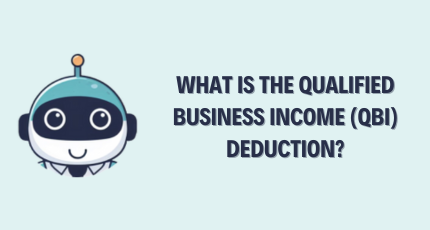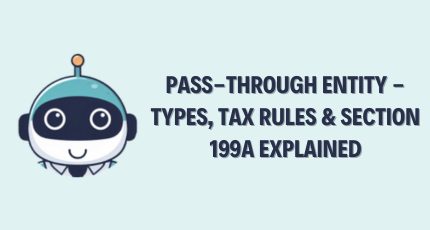What is the Qualified Business Income (QBI) Deduction?

The Qualified Business Income (QBI) deduction under Section 199A allows eligible pass‑through owners—sole proprietors, partners in partnerships, S corporation shareholders, and certain trusts/estates—to deduct up to 20% of qualified business income. Separate 20% components exist for qualified REIT dividends and qualified publicly traded partnership (PTP) income.
TL;DR — Qualified Business Income (QBI) Deduction (2025 Update)
- Law: Section 199A – Internal Revenue Code
- Purpose: Allows eligible pass-through owners to deduct up to 20% of QBI
- Made Permanent: The One Big Beautiful Bill Act (OBBBA, 2025) made the QBI deduction permanent
- Eligible Entities: Sole proprietorships, partnerships, S corporations, trusts, and estates
- Not Eligible: C corporations and employee wages
- Income Thresholds (2025):
- Single: $197,300–$247,300
- Joint: $394,600–$494,600
- New Minimum Deduction: $400 if QBI ≥ $1,000
- Forms: IRS Form 8995 or Form 8995-A
- Key Benefit: Reduces taxable income for pass-through businesses permanently under OBBBA 2025
Above income thresholds, you must apply the W‑2 wage/UBIA limitation and, for specified service trades or businesses (SSTBs), a phaseout. Claim the deduction on IRS Form 8995 or Form 8995‑A. C corporations never qualify.
Table of Contents
- What does “Qualified Business Income” Include and Exclude?
- Who Qualifies for the QBI deduction?
- How is the QBI deduction calculated (20% rule, wage/UBIA limits, SSTB phaseouts)?
- What Income is Excluded from QBI?
- How are REIT dividends, PTP income, and cooperatives treated under §199A?
- How Do I Claim the QBI Deduction (forms, statements, and workflow)?
- What Recent and Upcoming Law Changes Affect the QBI Deduction?
- How CPA Pilot Helps CPAs Automate and Document QBI Deductions?
- What Common QBI Questions Do Taxpayers Ask?
What does “Qualified Business Income” Include and Exclude?
QBI is generally net domestic ordinary business income from a qualified trade or business. It excludes: employee W‑2 wages, S‑Corp reasonable compensation, partnership guaranteed payments/§707(a) payments, and most investment items (capital gains/losses, dividends, and interest not properly allocable to the business). Income earned by a C corporation is never QBI.
Core definitions you’ll reference in reviews:
- Qualified trade or business: Any trade or business other than (1) services performed as an employee, and (2) a specified service trade or business (SSTB) when the owner’s taxable income exceeds the top of the SSTB phaseout range.
- Domestic requirement: Only U.S.‑source business income is QBI.
- Overall limitation: After computing all components, the total §199A deduction can’t exceed 20% of taxable income (before the QBI deduction) minus net capital gain.
- Negative QBI: Losses from one qualified business offset other QBI; if net QBI is negative, the amount carried forward to reduce future‑year QBI from qualified businesses.
- REIT/PTP bucket: Qualified REIT dividends and qualified PTP income are not QBI but get their own 20% components and their own carryforward bucket when negative.
Practitioner notes:
- Deductions properly allocable to the trade or business (e.g., deductible half of SE tax, SE health insurance, SE retirement contributions) reduce QBI.
- Keep workpapers for each activity showing QBI, W‑2 wages, UBIA, and SSTB? (Y/N).
Who Qualifies for the QBI deduction?
- Individuals (and certain trusts/estates) with domestic qualified trades or businesses conducted through sole proprietorships (Schedule C/F), partnerships, and S corporations. LLCs qualify when taxed as one of those. C corporations do not qualify. Employee wages are never QBI.
- SSTB categories (know the list): health, law, accounting, actuarial science, performing arts, consulting, athletics, financial services, brokerage services, investing/investment management, trading or dealing in securities/partnership interests/commodities, and any trade or business where the principal asset is the reputation or skill of one or more employees/owners (narrowly applied). Engineering and architecture are not SSTBs.
- Trusts & estates: The §199A deduction for estates and trusts is computed at the entity level; amounts may be allocated between the fiduciary and beneficiaries based on DNI and the character of the income. Keep a trust/estate‑specific schedule when beneficiaries receive K‑1s.
- Rental real estate: A rental activity can qualify as a trade or business under a facts‑and‑circumstances test. Many firms reference the rental real estate safe harbor (documented procedures, contemporaneous records, and 250+ hours for certain structures). Maintain safe‑harbor memos where relied upon.
How is the QBI deduction calculated (20% rule, wage/UBIA limits, SSTB phaseouts)?
- 20% base per business: For each qualified business, tentative amount = 0.20 × QBI.
- High‑income guardrail (per business): If taxable income is above the annual threshold, cap the tentative amount by the W‑2/UBIA limitation = greater of 50% of W‑2 wages or 25% of W‑2 wages + 2.5% of UBIA (unadjusted basis immediately after acquisition) of qualified property.
- Special components: Add 0.20 × qualified REIT dividends and 0.20 × qualified PTP income (these are not subject to W‑2/UBIA or SSTB limits).
- SSTB phaseout: If the owner’s taxable income is within the phaseout range, proportionally reduce the QBI, W‑2 wages, and UBIA inputs for SSTB businesses; above the top of the range, SSTB components are fully disallowed.
- Overall cap: Total §199A deduction ≤ 20% of taxable income (before the QBI deduction) − net capital gain.
- Loss mechanics: Negative QBI from one business offsets positive QBI from others. Net negative QBI carries forward to offset future‑year QBI. A negative REIT/PTP combined amount carries forward separately against future REIT/PTP components.
UBIA & Qualified Property (clarity you’ll need):
- UBIA is the original cost (unadjusted basis) of qualified property immediately after acquisition.
- Qualified property generally means tangible, depreciable property held by and available for use in the qualified trade or business and used during the year to produce QBI.
- UBIA is taken into account during the property’s depreciable period, which ends on the later of: (i) 10 years after placed‑in‑service, or (ii) the last full year of the regular recovery period for the property.
- Timing matters: Ensure placed‑in‑service dates are correct; acquisitions late in the year can materially change the W‑2/UBIA limitation.
Aggregation (When Helpful and How to Document):
- Owners may aggregate two or more businesses when they satisfy common‑ownership, same‑grouping, and operational‑interdependence rules (e.g., products/services are the same or customarily offered together, businesses share facilities, or operate in coordination).
- Aggregation can increase the W‑2/UBIA base and preserve more deduction.
- Once elected, aggregation must be consistently reported in future years and disclosed with an aggregation statement listing each business and the rationale.
Worked Examples (Clear Math):
- Overall cap example with net capital gain: Taxable income (pre‑QBI) $180,000, net capital gain $20,000 ⇒ overall cap = 20% × ($180,000 − $20,000) = $32,000. If business/REIT/PTP components total $36,000, allowed deduction is $32,000.
- Negative QBI carryforward: Year 1: Biz A QBI $(30,000), Biz B QBI $50,000 ⇒ net QBI $20,000 → compute deduction normally. Year 2 (carryover remains $0). If Year 1 net QBI were $(10,000) overall, carry $(10,000) to Year 2 to reduce that year’s QBI before applying the 20% rule.
Thresholds & phaseouts table: Maintain a small, year‑keyed table by filing status (Threshold, Phaseout range, SSTB treatment, W‑2/UBIA applies?). Update annually. Include a “Year” toggle in your CMS.
What Income is Excluded from QBI?
Excluded items include employee W‑2 wages, S‑corp reasonable compensation, partnership guaranteed payments/§707(a) payments, capital gains/losses, dividends, and most interest not allocable to the business, along with foreign‑source business income and any income of a C corporation.
Workpaper reminders:
- If an owner receives both comp/guaranteed payments and allocable ordinary income, only the allocable ordinary income may be QBI.
- Confirm at‑risk and passive loss rules before treating PTP items as “qualified.”
How are REIT dividends, PTP income, and cooperatives treated under §199A?
Qualified REIT dividends and qualified PTP income each get a separate 20% component—no W‑2/UBIA test and no SSTB limits—but the overall 20% taxable‑income cap still applies. Agricultural/horticultural cooperatives follow §199A(g) (a patron‑level deduction with its own wage cap and possible patron reduction of the §199A(a) amount).
REIT/PTP specifics:
- REIT dividends: Typically reported on 1099‑DIV; compute 20% × qualified REIT dividends. Maintain a carryforward ledger if the combined REIT/PTP amount is negative in a year (rare for REITs alone).
- PTP income: From K‑1 with §199A detail; apply passive/at‑risk rules before treating as qualified. PTP losses offset PTP income first; the combined REIT/PTP component can be negative and carry forward separately from business QBI.
- Ordering: Calculate business QBI amounts, then add the REIT/PTP component; apply the overall cap at the end.
Cooperatives (§199A(g)) quick map:
- Co‑ops may pass through a §199A(g) deduction (often via 1099‑PATR).
- The patron reduction rule can require reducing the taxpayer’s §199A(a) deduction when a §199A(g) amount is claimed.
- Keep a separate schedule for §199A(g) amounts and reductions; attach any co‑op statements to the return.
How Do I Claim the QBI Deduction (forms, statements, and workflow)?
Use Form 8995 (simplified) when under thresholds; use Form 8995‑A when over thresholds or when W‑2/UBIA, SSTB, aggregation, or complex REIT/PTP netting applies. The final figure flows to Form 1040. Retain QBI component, aggregation, REIT/PTP, and §199A(g) statements.
Form mechanics to know:
- Form 8995: Single‑page summary suited for returns at/below thresholds without SSTB or wage/UBIA computations.
- Form 8995‑A: Detailed computation with supporting schedules for (i) SSTB phase‑in, (ii) W‑2/UBIA calculations, (iii) aggregation, and (iv) REIT/PTP netting and carryforwards.
- Statement attachments: For each business include QBI, W‑2 wages, UBIA, SSTB flag, and note any aggregation election (list entities and rationale). Keep a carryforward roll‑forward for negative QBI and negative REIT/PTP.
8‑Step Filing Workflow:
- Scope activities; tag SSTB? and domestic?
- Build QBI per activity; exclude non‑QBI items.
- Compute 20% per business; compute 20% REIT/PTP separately.
- Apply high‑income tests (W‑2/UBIA; SSTB phaseout).
- Net & combine; then test the overall cap.
- Account for losses (QBI vs REIT/PTP carryforwards).
- Choose form (8995 vs 8995‑A) and attach statements.
- Flow to 1040 and archive a review checklist.
Want this workflow automated? Try CPA Pilot to pull K‑1/W‑2/UBIA data, compute §199A, and export 8995/8995‑A‑ready statements—plus client‑ready emails.
What Recent and Upcoming Law Changes Affect the QBI Deduction?
The QBI deduction is now permanent under the One Big Beautiful Bill Act (OBBBA, 2025). It no longer sunsets after 2025. The IRS continues to index thresholds and phaseout ranges annually. No structural changes to the deduction mechanics were made other than:
- Slightly expanded phase‑in/phase‑out ranges, starting in 2026 (see above).
- Introduction of the minimum $400 deduction for taxpayers with ≥$1,000 QBI from an active business.
- Minor language clarifications to SSTB definitions and aggregation disclosures.
Planning Impact:
- Permanent status allows long‑term projection of 20% QBI benefits in entity‑choice models and tax forecasts.
- Continue annual updates for thresholds and phaseout ranges.
- Use the new minimum deduction rule when clients have low‑income years with small positive QBI.
How CPA Pilot Helps CPAs Automate and Document QBI Deductions?
Turn QBI from a headache into a checklist. Automate §199A data capture, calculations, statements, and client emails with CPA Pilot—now fully aligned with OBBBA 2025 updates.
What CPA Pilot does for QBI:
- Automatically imports Schedule C/F, K‑1, W‑2, and UBIA data.
- Calculates 20% QBI, REIT/PTP components, and W‑2/UBIA limits under current thresholds.
- Flags SSTB status, applies phaseouts, and tracks the minimum $400 deduction rule.
- Generates Form 8995/8995‑A ready figures and aggregation statements.
- Maintains carryforward schedules (QBI + REIT/PTP) across years.
- Produces client‑ready summaries and emails explaining how the deduction was computed.
What Common QBI Questions Do Taxpayers Ask?
Which businesses qualify for the QBI deduction?
Owners of pass‑through entities—sole proprietorships (Schedule C/F), partnerships, S corporations, and certain trusts/estates—with domestic qualified trades or businesses. C corporations are not eligible.
Does a specified service trade or business (SSTB) qualify?
Yes, but only up to income thresholds. Inside the phaseout range, the deduction scales down; above the top, SSTB QBI is disallowed.
How Does the SALT Deduction Affect the QBI Deduction?
The State and Local Tax (SALT) deduction and the QBI deduction are separate, but both impact taxable income. Because the QBI deduction is limited by taxable income, a lower income after applying the SALT deduction can slightly reduce your QBI benefit if you’re near the phaseout thresholds.
How does the 20% rule work?
Take 20% of QBI per business, add 20% of qualified REIT dividends/PTP income, then apply the overall cap of ≤ 20% of taxable income (before QBI and net capital gains).
What is the W‑2 wage limitation and UBIA test?
Above thresholds, each business’s amount is capped by the greater of: 50% of W‑2 wages, or 25% of W‑2 wages + 2.5% of UBIA (unadjusted basis immediately after acquisition) of qualified property.
Which form do I file—Form 8995 or 8995‑A?
Use Form 8995 for simplified cases (generally at/below thresholds). Use Form 8995‑A when over thresholds or when wage/UBIA/SSTB/aggregation or REIT/PTP complexities apply.
Speed up QBI reviews, reduce rework, and send clean client explanations in minutes with CPA Pilot. Check Pricing now

![Bonus Depreciation – Rules, Elections & State Conformity [2025 Guide]](https://www.cpapilot.com/blog/wp-content/uploads/2025/10/Bonus-Depreciation.png)



